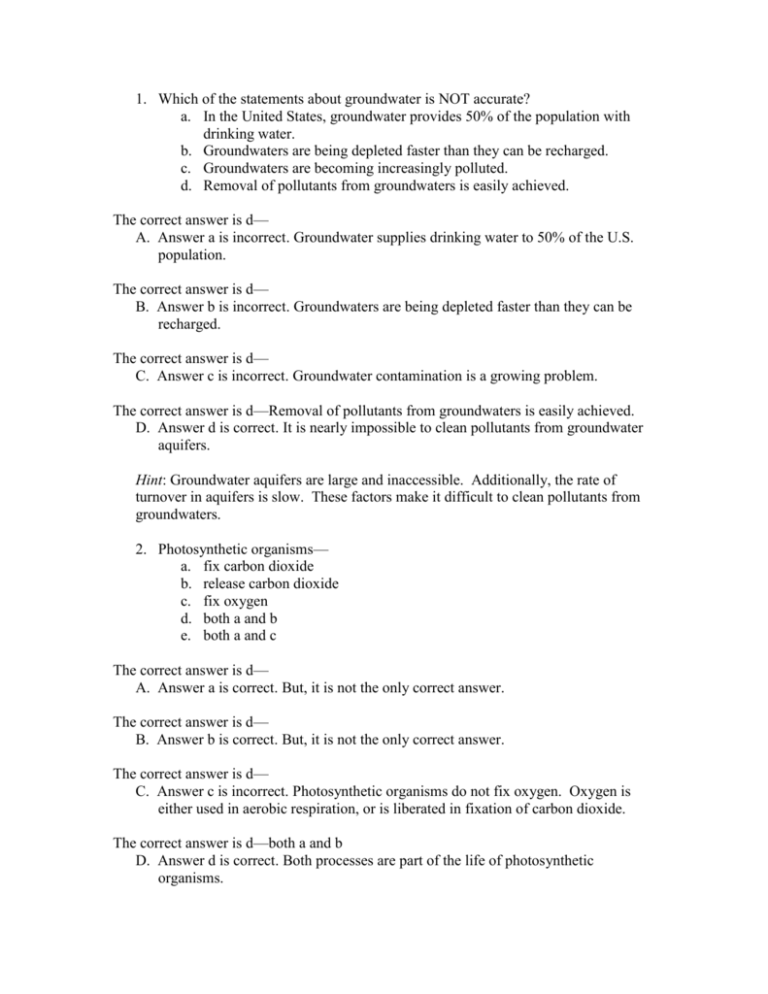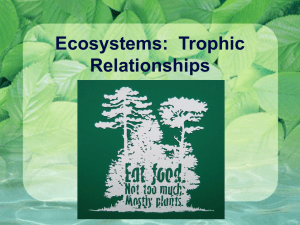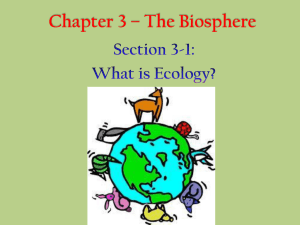Questions for Chapter 55 – Dynamics of Ecosystems
advertisement

1. Which of the statements about groundwater is NOT accurate? a. In the United States, groundwater provides 50% of the population with drinking water. b. Groundwaters are being depleted faster than they can be recharged. c. Groundwaters are becoming increasingly polluted. d. Removal of pollutants from groundwaters is easily achieved. The correct answer is d— A. Answer a is incorrect. Groundwater supplies drinking water to 50% of the U.S. population. The correct answer is d— B. Answer b is incorrect. Groundwaters are being depleted faster than they can be recharged. The correct answer is d— C. Answer c is incorrect. Groundwater contamination is a growing problem. The correct answer is d—Removal of pollutants from groundwaters is easily achieved. D. Answer d is correct. It is nearly impossible to clean pollutants from groundwater aquifers. Hint: Groundwater aquifers are large and inaccessible. Additionally, the rate of turnover in aquifers is slow. These factors make it difficult to clean pollutants from groundwaters. 2. Photosynthetic organisms— a. fix carbon dioxide b. release carbon dioxide c. fix oxygen d. both a and b e. both a and c The correct answer is d— A. Answer a is correct. But, it is not the only correct answer. The correct answer is d— B. Answer b is correct. But, it is not the only correct answer. The correct answer is d— C. Answer c is incorrect. Photosynthetic organisms do not fix oxygen. Oxygen is either used in aerobic respiration, or is liberated in fixation of carbon dioxide. The correct answer is d—both a and b D. Answer d is correct. Both processes are part of the life of photosynthetic organisms. The correct answer is d— E. Answer e is incorrect because photosynthetic organisms do not fix oxygen. 3. Nitrogen is often a limiting nutrient in many ecosystems because— a. there is much less nitrogen in the atmosphere than carbon b. elemental nitrogen is very rapidly used by most organisms c. nitrogen availability is being reduced by pollution due to fertilizer use d. most organisms cannot use nitrogen in its elemental form The correct answer is d— A. Answer a is incorrect. The Earth’s atmosphere consists of approximately 78% nitrogen. The correct answer is d— B. Answer b is incorrect. Elemental nitrogen can only be used directly by some microbial organisms that can fix it. The correct answer is d— C. Answer c is incorrect. Pollution due to fertilization is actually increasing the availability of nitrogen. The correct answer is d—most organisms can not use nitrogen in its elemental form. D. Answer d is correct. Most organisms require fixation of nitrogen to one of several forms, such as nitrites and nitrates, to produce biologically useful forms of nitrogen such as nitrites and nitrates. 4. Some bacteria have the ability to “fix” nitrogen. This means— a. they convert ammonia into nitrites and nitrates b. they convert atmospheric nitrogen gas into biologically useful forms of nitrogen c. they break down nitrogen-rich compounds and release ammonium ions d. they convert nitrate into nitrogen gas The correct answer is b— A. Answer a is incorrect. The conversion of ammonia into nitrites and nitrates is not nitrogen fixation. The correct answer is b—they convert atmospheric nitrogen gas into biologically useful forms of nitrogen B. Answer b is correct. Nitrogen fixation is the process of converting atmospheric nitrogen gas into a biologically useful form. The correct answer is b— C. Answer c is incorrect. The breaking down of nitrogen-rich compounds with the subsequent release of ammonium ions is a process known as ammonification. The correct answer is b— D. Answer d is incorrect. The process of converting nitrate into nitrogen gas is known as denitrification. Hint: Nitrogen fixation is the process whereby certain types of bacteria are able to cleave atmospheric nitrogen to produce biologically useful forms of nitrogen such as nitrites and nitrates. 5. Which of the following statements about the phosphorous cycle is correct? a. Phosphorous is fixed by plants and algae. b. Most phosphorous released from rocks is carried to the oceans by rivers. c. Animals cannot get their phosphorous from eating plants and algae. d. Fertilizer use has not affected the global phosphorous budget. The correct answer is b— A. Answer a is incorrect. Phosphorous is not available in gaseous form, so it is not fixed by any organism. The correct answer is b—Most phosphorous released from rocks is carried to the oceans by rivers. B. Answer b is correct. A large reservoir of phosphorous is located in rock, but much of that phosphorous is lost to weathering and transport by rivers to a relatively inaccessible sink, the ocean basins. The correct answer is b— C. Answer c is incorrect. Phosphorous contained in plant and algal tissue is a primary source for animals. The correct answer is b— D. Answer d is incorrect. Prior to regulations on the phosphate content of detergents, phosphorous was being artificially added to many ecosystems. 6. Based on results from studies at Hubbard Brook Experimental Forest, what would be the predicted effect of clearing trees from a watershed— a. increase loss of water and nutrients from a watershed b. decrease loss of water and nutrients from a watershed c. increase availability of phosphorous d. increase the availability of nitrate The correct answer is a—increase loss of water and nutrients from a watershed A. Answer a is correct. Monitoring of water and nutrient exchange showed a dramatic effect on mass balance of water and nutrients for the watershed. Nitrate, water, and calcium were lost relative to the undisturbed tracts of forest. The correct answer is a— B. Answer b is incorrect. Losses generally increased with a few exceptions. The correct answer is a— C. Answer c is incorrect. Phosphorous availability probably went down due to the removal of a large organic sink of phosphorous (the primary vegetation), and soli phosphorous appeared to be locked up in insoluble forms. The correct answer is a— D. Answer d is incorrect. Nitrate was lost rather than gained in the cleared tract compared with the undisturbed tract of forest. Hint: The undisturbed sites accumulated nitrogen at a rate of 2 kg/hectare/year. The disturbed sites lost nitrogen at a rate of 120 kg/hectare/year. 7. As a general rule, how much energy is lost in the transmission of energy from one trophic level to the one immediately above it? a. 1% b. 10% c. 90% d. 50% The correct answer is c— A. Answer a is incorrect. One percent would not even account for losses due to items in the lower trophic level being processed by detritivores. The correct answer is c— B. Answer b is incorrect. Ten percent is the amount of energy that is transmitted, not lost. The correct answer is c—90% C. Answer c is correct. In general, most of the energy within a trophic level does not pass up to the next trophic level. The correct answer is c— D. Answer d is incorrect. Fifty percent would represent an unusually high and rarely encountered value. 8. Inverted ecological pyramids of real systems usually involve— a. energy flow b. biomass c. energy flow and biomass d. none of the above The correct answer is b— A. Answer a is incorrect. Because the transmission of energy is reduced greatly as it moves from one trophic level to the next higher level, ecological energy pyramids cannot be inverted. The correct answer is b—biomass B. Answer b is correct. An inverted pyramid of biomass is possible if the standing crop of a highly productive level is rapidly reduced by the consumers on the next higher level (e.g., zooplankton consumption of phytoplankton). The correct answer is b— C. Answer c is incorrect. Because energy is greatly reduced as it moves up trophic levels, an inverted energy pyramid is not possible. The correct answer is b— D. Answer d is incorrect. One of the preceding answers is correct. 9. According to the trophic cascade hypothesis, the removal of carnivores from an ecosystem may result in— a. a decline in the number of herbivores and a decline in the amount of vegetation b. a decline in the number of herbivores and an increase in the amount of vegetation c. an increase in the number of herbivores and an increase in the amount of vegetation d. an increase in the number of herbivores and a decrease in the amount of vegetation The correct answer is d— A. Answer a is incorrect. Removing predators will result in an increase in herbivores, which will result in a decrease in vegetation. The correct answer is d— B. Answer b is incorrect. Removing predators will result in an increase in herbivores, which will result in a decrease in vegetation. The correct answer is d— C. Answer c is incorrect. Removing predators will result in an increase in herbivores, which will result in a decrease in vegetation. The correct answer is d—an increase in the number of herbivores and a decrease in the amount of vegetation D. Answer d is correct. Removing predators will result in an increase in herbivores, which will result in a decrease in vegetation. Hint: The trophic cascade hypothesis is a top-down system of ecosystem control. Organisms at one trophic level have effects on organisms at lower trophic levels. If top carnivores are removed from a system the number of herbivores is likely to increase. This will exert increased herbivory pressure on the vegetation of the system, and most likely result in a decrease in vegetation. 10. Bottom-up effects on trophic structure result from— a. a limitation of energy flowing to the next higher trophic level b. actions of top predators on lower trophic levels c. climatic disruptions on top consumers d. stability of detritivores in ecosystems The correct answer is a—a limitation of energy flowing to the next higher trophic level A. Answer a is correct. A bottom-up effect ultimately results from changes in energy availability. In general, higher trophic levels have minimum requirements for energy flow from lower trophic levels. The correct answer is a— B. Answer b is incorrect. It refers to what would be identified as a top-down effect. The correct answer is a— C. Answer c is incorrect. Climatic effects could affect trophic interactions, but they would have to drive changes in the producers, not top consumers, for it to lead to a bottom-up effect. The correct answer is a— D. Answer d is incorrect. Detritivores represent an important way for energy to be made available to lower levels of an ecosystem, so if they are stable, then no bottom-up changes would be expected. 11. At Cedar Creek Natural History Area, experimental plots showed reduced numbers of invaders as species diversity of plots increased— a. suggesting that low species diversity increases stability of ecosystems b. suggesting that ecosystem stability is a function of primary productivity only c. consistent with the theory that intermediate disturbance results in the highest stability d. none of the above The correct answer is d— A. Answer a is incorrect. The experimental result suggests just the opposite—that increasing species diversity leads to greater stability. This assumes that invasion success is a reasonable measure of stability. The correct answer is d— B. Answer b is incorrect. The plots did not necessarily differ systematically in productivity. The correct answer is d— C. Answer c is incorrect. Disturbance was not a factor that varied among plots included in the description of the experimental results. The correct answer is d—none of the above D. Answer d is correct. None of the answers is valid. 12. Species diversity— a. increases with latitude as you move away from the equator to the arctic b. decreases with latitude you move away from the equator to the arctic c. stays the same you move away from the equator to the arctic d. increases with latitude as you move north of the equator and decreases with latitude as you move south of the equator The correct answer is a—increases with latitude as you move away from the equator to the arctic A. Answer a is correct. The correct answer is a— B. Answer b is incorrect. The tropics are more species-diverse than the arctic regions. The correct answer is a— C. Answer c is incorrect. Species diversity varies with latitude. The correct answer is a— D. Answer d is incorrect. Species diversity does not change in opposite directions north and south of the equator. 13. The equilibrium model of island biogeography suggests all of the following except— a. larger islands have more species than smaller islands b. the species richness of an island is determined by colonization and extinction c. smaller islands have lower rates of extinction d. islands closer to the mainland will have higher colonization rates The correct answer is c— A. Answer a in incorrect. In general, larger islands have greater species richness than smaller islands. The correct answer is c— B. Answer b is incorrect. The equilibrium model states that species richness is a balance between colonization and extinction. The correct answer is c—smaller islands have lower rates of extinction C. Answer c is correct. Smaller islands tend to have higher rates of extinction than larger islands. The correct answer is c— D. Answer d is incorrect. Islands closer to the mainland have higher colonization rates than more distant islands. Hint: Smaller islands will have smaller populations of individuals living on them because there will be fewer resources to support these populations. Small populations have a higher chance of going extinct than larger populations. Challenge Questions 1. Given that ectotherms do not utilize a large fraction of ingested food energy to maintain a high and constant body temperature (generate heat), how would you expect the food chains of systems dominated by ectothermic herbivores and carnivores to compare with systems dominated by endothermic herbivores and carnivores? Answer—Because the length of food chains appears to be ultimately limited by the amount of energy entering a system, and the characteristic loss of usable energy (about 90%) as energy is transferred to each higher level, it would be reasonable to expect that the ectotherm-dominated food chains would be longer than the endotherm-dominated chains. In fact, there is some indirect evidence for this from real food chains, and it is also predicted by some advanced ecological models. However, whether in reality such is the case, is difficult to determine due to all of the complex factors that determine food chain length and structure. Moreover, there are many practical difficulties associated with measuring actual food chain length in natural systems. 2. Given that, in general, energy input is greatest at the bottom trophic level (primary producers) and decreases with increasing transfers across trophic levels, how is it possible for many lakes to show much greater standing biomass in herbivorous zooplankton than in the phytoplankton they consume? Answer—It is critical to distinguish, as this chapter points out, between energy and mass transfer in trophic dynamics of ecosystems. The standing biomass of phytoplankton is not necessarily a reliable measure of the energy contained in the trophic level. If phytoplankton are eaten as quickly as they are produced, they may contribute a tremendous amount of energy, which can never be directly measured by a static biomass sample. The standing crop therefore, is an incomplete measure of the productivity of the trophic level. 3. Ecologists often worry about the potential effects of the loss of species (e.g., due to pollution, habitat degradation or other human induced factors) on an ecosystem for reasons other than just the direct loss of the species. Using Figure 57.17, explain why. Answer—As Figure 57.17 suggests, trophic structure and dynamics are interrelated and are primary determinants of ecosystem characteristics and behavior. For example, if a particularly abundant herbivore is threatened, energy that is abundant at the level of primary productivity in an ecosystem may be relatively unavailable to higher trophic levels (e.g., carnivores). That is, the herbivores are an important link in transducing energy through an ecosystem. Cascading effects, whether they are driven from the bottom up or from the top down are a characteristic of energy transfer in ecosystems, and that translates into the reality that effects on any particular species are unlikely to be limited to that species itself. 4. Explain several detailed ways in which increasing plant structural complexity could lead to greater species richness of lizards (Figure 57.20b). Could any of these ideas be tested? How? Answer—There are many ways to answer this question, but the obvious place to start is to think about the many ways plant structural diversity potentially affects animals that are not eating the plants directly. For example, plants may provide shelter, refuges, food for prey, substrate for nesting, among other things. Therefore, increasing complexity might increase the ability of lizards to partition the habitat in more ways, allow more species to escape their predators or seek refuge from harsh physical factors (such as, cold or hot temperatures), provide a greater substrate for potential prey in terms of food resources, for instance. If we want to know the exact mechanisms for the relationship, we would need to conduct experiments to test specific hypotheses. For example, if we hypothesize that some species that require greater structural complexity in order to persist in a particular habitat, we could modify the habitat (reduce plant structure) and test whether species originally present were reduced in numbers or became unable to persist.






